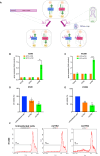RNA-mediated inhibition of mitochondrial SHMT2 impairs cancer cell proliferation
- PMID: 40770176
- PMCID: PMC12328718
- DOI: 10.1038/s41420-025-02646-y
RNA-mediated inhibition of mitochondrial SHMT2 impairs cancer cell proliferation
Abstract
Targeting metabolic reprogramming is crucial for cancer treatment. Recent advances highlight RNA's ability to directly regulate enzyme activity through riboregulation. In this study, we used an RNA-based approach to inhibit the mitochondrial enzyme Serine hydroxymethyltransferase 2 (SHMT2), which lacks a selective in vivo inhibitor. SHMT2, often overexpressed in various cancers, is pivotal in one-carbon metabolism, a pathway vital for cell proliferation. Our results show that RNA effectively inhibits SHMT2's serine-to-glycine conversion in vitro (IC50 = 4.4 ± 0.2 nM). By using a mitochondrial import signal, we successfully delivered the inhibitory RNA into the mitochondria of lung cancer cells, reducing cell viability in vitro and tumor growth in vivo in a xenograft mouse model. These findings suggest that RNA-based strategies could be extended to selectively target other RNA-binding metabolic enzymes, offering potential solutions where small molecule inhibitors fall short or to counteract drug resistance.
© 2025. The Author(s).
Conflict of interest statement
Competing interests: The authors declare no competing interests. Ethics approval and consent to participate: All methods were performed in accordance with the relevant guidelines and regulations. All animal experiments were carried out under the authorization n° 312/2021-PR of the Italian Ministry of Health. Informed consent was not obtained, as this study does not involve patients.
Figures





References
Grants and funding
- AR22419078021B75/Sapienza Università di Roma (Sapienza University of Rome)
- RM12117A5BDD4AEC/Sapienza Università di Roma (Sapienza University of Rome)
- RP12117A675EDA46/Sapienza Università di Roma (Sapienza University of Rome)
- 2022KC3X9L/Ministero dell'Istruzione, dell'Università e della Ricerca (Ministry of Education, University and Research)
LinkOut - more resources
Full Text Sources

